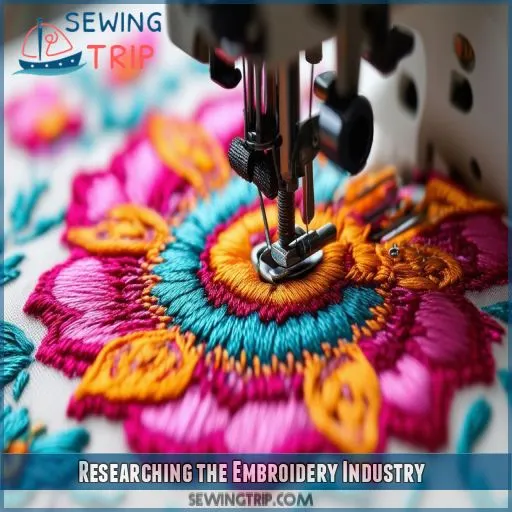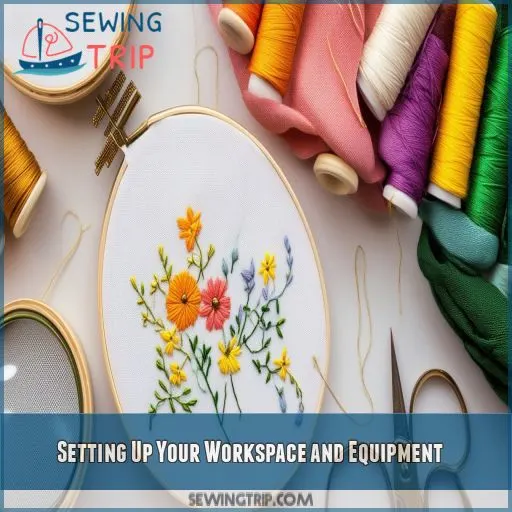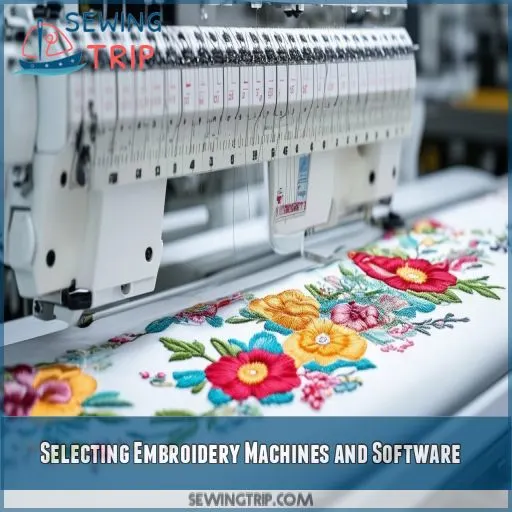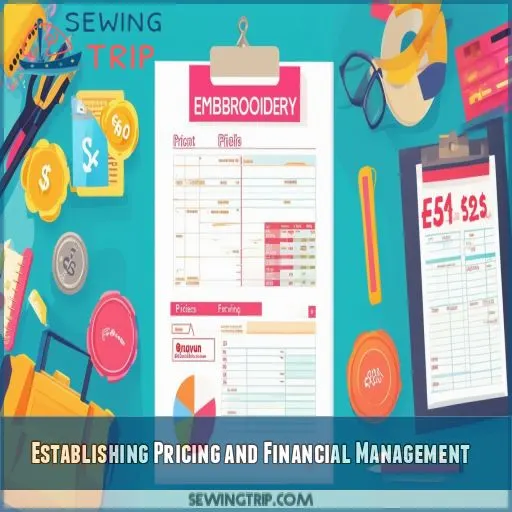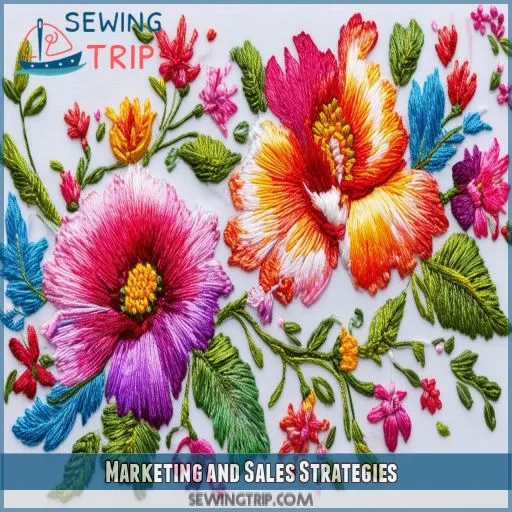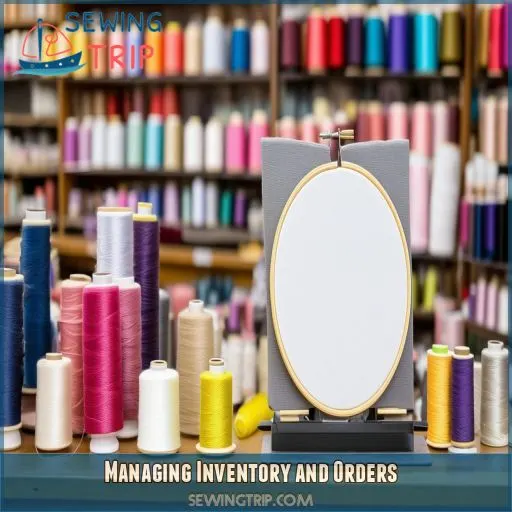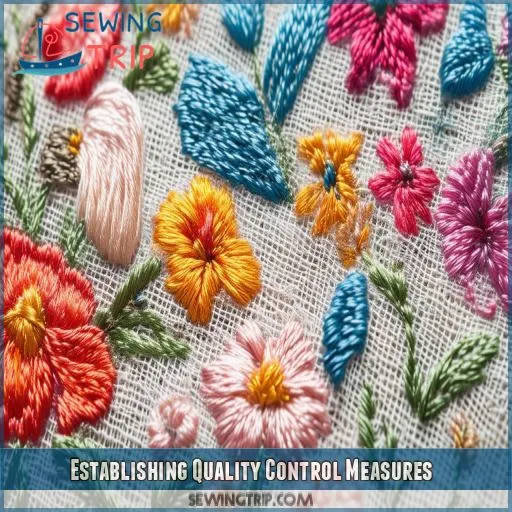This site is supported by our readers. We may earn a commission, at no cost to you, if you purchase through links.
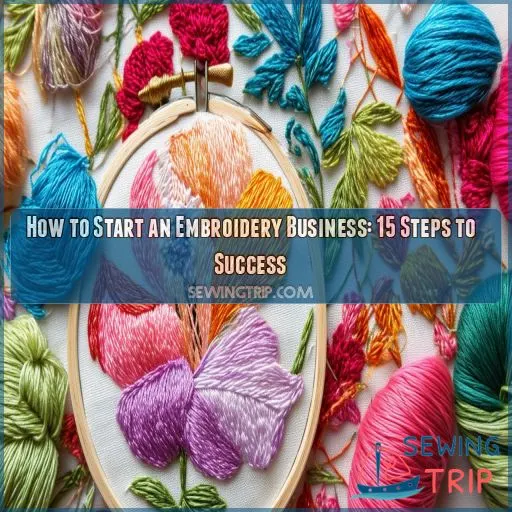
This guide outlines 15 essential steps to start an embroidery business successfully. You’ll learn how to research the industry, identify your niche, create a solid business plan, and set up your workspace.
With determination and the right knowledge, you can master the art of embroidery entrepreneurship and stitch your way to success.
Table Of Contents
- Key Takeaways
- How to Start an Embroidery Business in 15 Steps?
- Researching the Embroidery Industry
- Identifying Your Niche and Target Audience
- Creating a Business Plan
- Securing Necessary Licenses and Permits
- Setting Up Your Workspace and Equipment
- Selecting Embroidery Machines and Software
- Establishing Pricing and Financial Management
- Marketing and Sales Strategies
- Managing Inventory and Orders
- Establishing Quality Control Measures
- Frequently Asked Questions (FAQs)
- Conclusion
Key Takeaways
- Stitch together a solid foundation: Research the embroidery industry, identify your niche, and create a business plan that’s as detailed as an intricate cross-stitch pattern.
- Thread the needle of success: Invest in quality equipment and software, but don’t get tangled up in unnecessary expenses. Remember, even the most elaborate tapestry starts with a single stitch!
- Embroider your way to financial stability: Set smart pricing strategies, manage inventory like a pro, and keep your finances as neat as a French knot.
- Weave a web of loyal customers: Market your creations like they’re wearable works of art, provide top-notch customer service, and watch your business blossom like a beautifully embroidered flower.
How to Start an Embroidery Business in 15 Steps?
To start an embroidery business in 15 steps, you’ll need to roll up your sleeves and immerse yourself in the realm of stitches and threads. Begin by researching the industry and identifying your niche.
Create a solid business plan, secure necessary licenses, and set up your workspace. Choose the right equipment and software, then establish pricing and financial management strategies.
Don’t forget to market your services and manage inventory effectively. As you stitch your way to success, focus on quality control to set yourself apart.
From selecting the perfect needle to threading the path to entrepreneurship, each step is essential. The journey ahead is filled with vibrant opportunities and intricate challenges.
Researching the Embroidery Industry
Researching the embroidery industry is an essential first step in starting your business. It’s like mapping out a journey before setting out on an adventure—you need to understand the embroidery market, industry trends, and competition to navigate your path to success.
Begin a fact-finding mission to uncover the secrets of the embroidery industry’s success. Join industry associations, attend trade shows, and devour publications to learn the ins and outs of the business. This will help you identify your target customers and understand their needs. Spot gaps in the market that your unique embroidery niche can fill.
Identifying Your Niche and Target Audience
Prior to embarking on your embroidery business journey, it’s essential to define your niche and target audience. Here’s how:
- Niche Selection: Opt for a specialized market segment that attracts a targeted audience. Address unmet needs and challenges of potential customers. Reflect on their passions, interests, and values. Analyze existing embroidery businesses and remain informed about current trends to identify unique opportunities.
- Target Audience: Identify your ideal customers. Consider their demographics, interests, and purchasing power. Are you catering to individuals who value personalized fashion, or are you targeting businesses that require embroidered uniforms or promotional items? Understanding your target audience is paramount for effective embroidery marketing.
- Market Analysis: Research and understand the embroidery industry. Join industry associations, attend trade shows, and read publications to stay informed. This knowledge will assist you in identifying gaps in the market and unique embroidery niches to explore.
- Customer Segmentation: Divide your target audience into specific groups based on their characteristics and needs. This will help you tailor your embroidery products and marketing strategies to different customer types.
- Business Differentiation: Set yourself apart from the competition. Offer something unique or focus on a specific embroidery niche that others might overlook. This could be a specific type of design, technique, or product offering.
Embroidery businesses can succeed by understanding their niche and target audience. Focus on these aspects to establish a solid foundation for your venture.
Creating a Business Plan
Now that you’ve identified your niche and target audience, it’s time to delve into the specifics of creating a comprehensive business plan. This is where you’ll establish the foundation for your embroidery empire, outlining every detail from finances to marketing strategies.
A solid business plan is essential for any entrepreneur, and it’s your secret weapon to securing funding, attracting investors, and, most importantly, ensuring your own success. So, grab your favorite pen or start your word processor, and let’s get to work.
First, outline the opportunity. What gap in the market are you filling? What sets your embroidery business apart from the rest? Next, detail your execution strategy, including your marketing and sales approach, and how you plan to reach your target audience. Don’t forget to include financial projections, embroidery pricing, and income estimates, along with a risk assessment to show you’ve considered potential challenges. Finally, provide an overview of your management structure and legal compliance, ensuring all your bases are covered.
Securing Necessary Licenses and Permits
Now that you’ve crafted a business plan, it’s time to explore the legal requirements of your embroidery venture. This step is essential, as it guarantees your business adheres to local regulations and shields you from legal concerns in the future. Here’s a breakdown of the licenses and permits you might need:
- Business License: This is a fundamental requirement for operating a business legally and is typically required for all types of enterprises. You can obtain this from your local government or municipality.
- Seller’s Permit: If you’re selling directly to customers, you’ll need this permit to collect and remit sales tax.
- Home Occupation Permit: If your business is home-based, this permit may be necessary, depending on your location.
- Trade Name Registration: Planning to use a catchy business name? Register it with the appropriate government agency to make it official.
Setting Up Your Workspace and Equipment
Now that you’ve secured the necessary licenses and permits, it’s time to set up your embroidery workspace and choose your equipment. This is an important step, as a well-organized and efficient workspace can improve your productivity and the overall success of your business. Here are some key considerations for setting up your embroidery workspace and choosing your equipment:
| Consideration | Description | Tips |
|---|---|---|
| Workspace Layout | Plan the layout to guarantee efficient movement and storage of equipment. | Create dedicated zones for different tasks, such as a cutting area, stitching station, and packing zone. |
| Equipment Storage | Determine how you’ll store embroidery equipment and supplies. | Invest in storage solutions for easy access. |
| Ventilation and Lighting | Ensure adequate ventilation and lighting for a comfortable, functional environment. | Consider additional lighting or ventilation systems. |
| Ergonomics | Design your workspace to prevent physical strain and improve comfort. | Adjust table and chair heights for good posture. |
| Embroidery Equipment | Choose equipment, including machines, software, and tools, based on production goals and budget. | Select a machine with features like a warranty, training, and support. |
Selecting Embroidery Machines and Software
To select the right embroidery machines, you’ll need to evaluate key features like stitch quality and speed, ensuring they align with your production targets. Additionally, the software you choose should be user-friendly, offering robust design capabilities to streamline your workflow.
Machine Features
Now that you’ve set up your workspace, it’s time to select the right embroidery machine to bring your designs to life. This decision will depend on various factors, including your budget, desired features, and brand preferences.
You can choose from a range of embroidery machine brands, including Brother, Janome, Juki, Eversewn, Melco, Ricoma, and Necchi. Some machines cater to beginners with affordable options, while others, like the Janome MB-7, offer serious production power with multiple needles for tackling large projects.
Modern machines come equipped with wireless technology, cloud connectivity, and USB capabilities, making design loading a breeze. If you’re after cutting-edge technology and professional-grade performance, consider the Brother Luminaire XP3, Baby Lock Solaris Vision, Husqvarna Viking Epic 2, or Bernina 790 PRO, all of which offer a range of advanced features.
Software Options
When selecting embroidery software, consider these key factors:
- Interface Compatibility: Confirm that the software integrates seamlessly with your embroidery machine. Check for compatibility with specific machine models and brands to avoid issues.
- File Format Conversion: Opt for software that supports various file formats. This feature ensures you can work with different design formats and easily convert them for embroidery.
- Design Optimization: Look for tools that enhance your designs, offering features like stitch editing, design resizing, and embroidery-specific effects.
Research thoroughly and choose software that aligns with your specific needs and goals.
Production Goals
When selecting embroidery machines and software, consider your production goals. How many embroidered products do you plan to create daily or weekly? This will guide your equipment investment. Aim for production efficiency with machines that can handle higher volumes if you’re targeting larger orders. Make sure the equipment is compatible with the materials you plan to use, be it for embroidery designs, embroidery apparel, or other embroidered products.
Seek machines that offer complete training and support, along with warranty and maintenance services. This will ensure you can quickly address any issues and minimize downtime, keeping your operations running smoothly.
Establishing Pricing and Financial Management
Now that you’ve selected your embroidery machines and software, it’s time to establish your pricing and financial management strategy. This is an essential aspect of your business, as it will impact your profitability and long-term success.
Determining your embroidery prices is a delicate balance. You’ll need to take into account factors such as your stitch rate or hourly fee, the cost of materials, and the time and expertise required for each project. Researching your competitors’ pricing can also help you set rates that are competitive yet profitable.
Financial management involves budgeting, profitability analysis, and keeping track of your expenses. It’s critical to manage your cash flow, pay your bills on time, and closely monitor your finances to ensure the stability and growth of your embroidery business.
As you develop your financial plan, consider seeking advice from accountants or financial advisors who can provide valuable insights and help you make informed decisions about your business’s financial future.
Marketing and Sales Strategies
Now that you’ve established your pricing strategy and financial management practices, it’s time to focus on marketing and sales. This is where you’ll spread the word about your unique embroidery offerings and convert interested individuals into paying customers. Here are some strategies to examine:
- Social Media Marketing: Identify the social media platforms your target audience frequents, such as Instagram, Facebook, or Pinterest. Create engaging content that showcases your embroidery skills and designs. Use hashtags effectively to reach a wider audience and consider running paid advertising campaigns to boost your reach.
- Email Campaigns: Build an email list and send targeted campaigns to showcase new designs, announce promotions, or provide valuable content. This helps keep your business top of mind and can drive repeat purchases.
- Influencer Partnerships: Collaborate with influencers or embroidery enthusiasts who’ve a substantial following. This can help expand your reach and build trust with potential customers.
- Content Creation: Create valuable content beyond social media posts, such as blog posts or YouTube videos, that educates or inspires your target audience. This can establish your business as a thought leader in the embroidery space and drive organic traffic to your website.
Managing Inventory and Orders
Managing inventory and orders is essential to your embroidery business’s success. Efficient order management and inventory tracking guarantee you can fulfill orders promptly and avoid disappointing customers.
Implement a robust inventory management system to monitor stock levels and prevent running out of supplies mid-order. Regularly review and update your inventory, accounting for every thread, fabric, and accessory. Utilize embroidery forums to learn about effective inventory management strategies specific to the embroidery industry.
Additionally, establish a seamless order processing system. Clearly communicate with customers about their orders, providing updates and estimated completion times. Efficient order fulfillment not only keeps customers happy but also guarantees you get paid on time. Consider hiring embroidery employees to assist with order management and fulfillment if demand increases.
Establishing Quality Control Measures
Now that you’ve got your inventory and orders under control, it’s time to discuss quality control. This is a critical step in guaranteeing your embroidery business succeeds and builds a solid reputation. Here’s how to establish quality control measures:
- Quality Assurance: Implement consistent standards for your embroidery work. This includes stitch quality, thread tension, and overall design placement. Regularly inspect your products to make sure they meet these standards.
- Testing Procedures: Develop a process to test your embroidery designs before finalizing them. This could include testing on different fabrics, thread colors, and embroidery techniques to guarantee durability and aesthetics.
- Inspection Methods: Train your staff (or yourself) to conduct thorough inspections of finished products. Check for any flaws, such as missed stitches, uneven tension, or fabric defects. Use this feedback to enhance future products.
- Feedback Mechanisms: Encourage customer feedback on your products. This can be done through surveys, reviews, or social media interactions. Use this feedback to identify areas for improvement and make necessary adjustments to your processes.
Frequently Asked Questions (FAQs)
How do I start my own embroidery business?
You’ll need to define your niche, invest in equipment, develop designs, and set up your business legally. Create a marketing plan, establish pricing, and build a network. Start small, learn constantly, and grow your skills and customer base.
How much does it cost to start an embroidery business?
Like planting a garden, starting an embroidery business requires careful investment. You’ll need $5,000 to $15,000 for equipment, supplies, and initial marketing. Costs vary based on your chosen machine, software, and business scale. Plan wisely to nurture your venture’s growth.
Is embroidery a profitable business?
Yes, embroidery can be profitable. You’ll need to target the right niche, invest in quality equipment, and deliver exceptional products. With smart pricing and efficient operations, you can turn a healthy profit in this creative business venture.
How do you start an embroidery project for beginners?
Start with simple designs on scrap fabric. You’ll need embroidery hoops, needles, floss, and scissors. Choose a pattern, transfer it onto fabric, and begin stitching. Practice basic stitches like running and backstitch before advancing to more complex techniques.
How long does it take to become profitable?
You’ll typically need 6-12 months to become profitable in embroidery. It depends on your investment, marketing efforts, and niche selection. Stay persistent, refine your skills, and build a loyal customer base to accelerate your journey to profitability.
What are common mistakes new embroidery businesses make?
Diving headfirst without a life vest, you’ll sink fast. Common blunders include underpricing, overcommitting, neglecting marketing, and skimping on quality. Don’t overlook proper training, ignoring customer feedback, or failing to diversify your product line. Stay afloat by avoiding these pitfalls.
Can I start part-time while working another job?
Yes, you can start part-time while keeping your day job. It’s a smart way to test the waters, build skills, and grow your business gradually. Just manage your time wisely and set realistic goals for your side hustle.
How do I handle difficult or dissatisfied customers?
Tame the storm of customer discontent with a cool head and warm heart. Listen actively, empathize sincerely, and offer solutions promptly. Turn complaints into opportunities by going above and beyond, transforming frustrated clients into loyal brand ambassadors.
What eco-friendly practices can I incorporate into my business?
You can use organic threads, eco-friendly dyes, and recycled packaging. Opt for energy-efficient machines and solar power. Partner with sustainable suppliers, offer repair services, and educate customers on product care. Implement a waste reduction program in your workshop.
Conclusion
Just as Arachne’s legendary tapestries wove tales of wonder, you too can spin your passion into a thriving enterprise. By following these 15 steps to start an embroidery business, you’ll transform your craft into a successful venture.
From researching the industry to establishing quality control, you’ve now got the blueprint for success. Remember, every stitch counts in building your embroidery empire.
Stay focused, adapt to market trends, and continuously refine your skills. With dedication and creativity, you’ll soon be stitching your way to entrepreneurial success.

